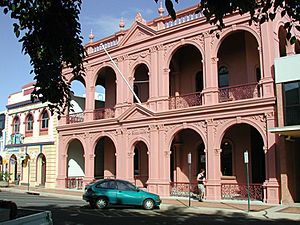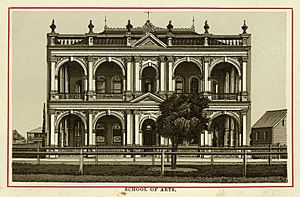Bundaberg School of Arts facts for kids
Quick facts for kids Bundaberg School of Arts |
|
|---|---|

Bundaberg School of Arts
|
|
| Location | 184 Bourbong Street, Bundaberg Central, Bundaberg, Bundaberg Region, Queensland, Australia |
| Design period | 1870s–1890s (late 19th century) |
| Built | 1888–1889 |
| Architect | Anton Hettrich |
| Architectural style(s) | Classicism |
| Official name: Bundaberg School of Arts | |
| Type | state heritage (built) |
| Designated | 21 October 1992 |
| Reference no. | 600362 |
| Significant period | 1889–1940s (historical) 1880s–1890s (fabric) 1889–1940s (social) |
| Significant components | decorative features, verandahs – arcaded, school of arts |
| Lua error in Module:Location_map at line 420: attempt to index field 'wikibase' (a nil value). | |
The Bundaberg School of Arts is a special old building in Bundaberg, Queensland, Australia. It used to be a "school of arts," which was like a community learning center. Today, it serves as a community hub.
This beautiful building was designed by an architect named Anton Hettrich. It was built between 1888 and 1889. Because of its history and design, it was added to the Queensland Heritage Register on October 21, 1992.
A Look Back: History of the Building
The Bundaberg School of Arts is a strong brick building. It was built in a classical style, which means it looks like old Greek or Roman buildings. This was the third "school of arts" building on this spot.
Bundaberg's Early Days
Bundaberg is in an area called Burnett. European settlers first came here in the 1840s and 1850s. They set up large farms for animals. Later, in the 1860s, people started looking for good land to grow crops. They found it along the Burnett River.
The town of Bundaberg was officially mapped out in 1869. It grew quickly because of river traffic. Copper was also found nearby in 1871. This helped Bundaberg become an important port and supply center. Sugar farms grew around the town. The sugar industry made Bundaberg very rich from the 1880s to the 1920s.
The First School of Arts
In 1871, some land was set aside for a School of Arts. At that time, only about 100 people lived in Bundaberg. Soon after, the first School of Arts opened. It was a simple wooden building. It had a reading room and a library. Most of the books were fiction stories. People also used it for meetings and church services.
What Were Schools of Arts?
The first Schools of Arts started in Britain in the early 1800s. They were created to help people learn and grow. They offered lectures, discussions, and libraries. This was important because there were no free public libraries back then. Books were also very expensive.
In Queensland, the first School of Arts started in Brisbane in 1849. Its goal was to help the community learn about literature, philosophy, and science. As towns grew, local groups set up their own Schools of Arts. These became key places for adults to learn. The government helped by giving land, money for books, and help with building costs.
A New Building and a Great Library
A new wooden School of Arts building was built in Bundaberg in 1880. The library got a big boost from Thomas McIlwraith. He later became the Premier of Queensland. He donated three cases of English classic books. The Book Committee also bought 1,400 more books. This made the library very good.
In the 1880s, Bundaberg was becoming very wealthy. Old wooden buildings were being replaced with grand brick ones. The School of Arts needed a bigger, more impressive building. The land it was on had become very valuable. It was at a main intersection, near the post office and bank.
The committee asked the government if they could sell part of the land. This would help them pay for a new building. The government agreed, and they sold some land for £3,400.
Designed by a Local Architect
The new building was designed by Anton Hettrich. He was a local architect who trained in Germany. He started his business in Bundaberg in 1884. He also designed the Bundaberg Town Hall.
Hettrich won the competition to design the School of Arts in 1888. He worked with a builder named William Champ on this project. Hettrich was a long-time member of the School of Arts committee. He also taught drawing and German there. He designed over 300 buildings in the Bundaberg area.
Construction of the new building began on June 2, 1888. The old building was moved to the back of the site. This allowed services to continue. The new building was finished on April 16, 1889. It cost £3,300.
What Was Inside?
The new building had a library and rooms for rent on the ground floor. There was also a committee room. Upstairs, there was a large reading room. It opened onto a verandah. There was also a natural history museum and chess rooms. Everyone was very happy with the "elegant and substantial edifice." They felt it was perfect for its purpose.
Classes and Changes Over Time
From 1889, the School of Arts offered many classes. These included drawing, shorthand, bookkeeping, typing, dressmaking, and carpentry. These classes were very popular. In 1898, a wooden hall was built behind the School of Arts. It had a stage and a piano. This hall was also rented out.
However, in 1908, the government took over responsibility for technical classes. This was one reason why Schools of Arts started to close down.
Membership to the School of Arts required a fee. The number of members was never huge. Many important local people, including mayors, helped run the institute. A gallery was added to the library in the early 1900s. Membership dropped for a while. But it rose again in the 1920s. This led to the library being made bigger.
Even during the Great Depression, the Bundaberg School of Arts did well. Many other Schools of Arts closed when government funding stopped.
In 1928, a new building next door blocked light. So, the verandah on that side was removed. The other verandah was removed a few years later. Over time, people had more choices for learning and fun. Also, a law in 1943 created free public libraries. These changes led to many Schools of Arts closing.
Bundaberg's museum collection was split up after World War II. But the money from rentals and the excellent library helped the School of Arts survive. In 1969, the Bundaberg and District Museum was formed. It moved into the hall the next year.
The School of Arts library was the only lending library in Bundaberg until the 1970s. Then, the city council looked into starting a free public library. The future of the building was uncertain. But members of the Bundaberg Historical Society helped save it.
In 1976, the City of Bundaberg repaired the building. In 1979, the School of Arts building and its assets were given to the Bundaberg City Council. The library moved to the former Customs House in 1981. The Bundaberg Art Society then used the library room as an art gallery. In 1988, the museum moved to a new building. The art gallery also moved out in the late 1990s. Today, the building is still used for cultural and community events. People can rent it for different purposes.
What the Building Looks Like
The former School of Arts is a large, two-story brick building. It is painted and looks like a classical building. It is located near a main intersection in Bundaberg's town center. Newer buildings are now on either side of it.
The building is shaped like a rectangle. It has a sloped roof covered with corrugated iron. The roof is hidden from the street by a decorative wall. This wall has small pillars and cement urns on top.
The most striking part of the building is its two-story verandah. This verandah has arches along the front. It also wraps around for three sections on each side. The arches are made of painted brick. On both levels, there is a central arch with a small triangle on top. This arch is flanked by two larger arches. These arches have decorative columns with fancy tops. There are also cast-iron railings between the columns. The spaces between the arches and columns are decorated with a wreath and ribbon design.
Wooden verandahs on each side of the building have been rebuilt. They look like the original ones. The walls behind them show the original brick. The brick at the back of the building is painted. The windows have two parts that slide up and down. They also have rounded tops, just like the arches at the front. The hallways inside also have arches.
The inside of the building is still in good condition. The walls on the ground floor are plastered brick. There is a central hall. From this hall, you can reach the old library and offices. The main staircase at the back of the hall is curved. It has two decorative alcoves and a window. The staircase has a wooden railing. It leads to a landing on the first floor. A short hall connects this landing to the old reading room. There are smaller rooms on the left and right. The inner walls are made of narrow wooden boards. The ceilings and decorative moldings are also made of timber.
The doors have fancy carved panels above them. These panels show a lyre (a musical instrument) and a leaf design. This classical design fits a place dedicated to education and the arts.
Why It's a Heritage Site
The Bundaberg School of Arts was added to the Queensland Heritage Register on October 21, 1992. It met several important requirements.
Showing Queensland's History
The Bundaberg School of Arts is important because it shows how Queensland grew. Schools of Arts were common in many towns in the 1800s and early 1900s. They showed how rich and advanced a town was. The size and style of this building show how wealthy Bundaberg was as a sugar city. Schools of Arts were run by the community. They helped share information and provided places for talks, meetings, games, and community events. They were a key part of adult education in Queensland.
A Great Example of Its Kind
This building is a good example of a major regional School of Arts. It had a library, a reading room, a committee room, and a museum.
Beautiful and Important Design
It is a well-designed and impressive building. Its shape, size, and location near a main intersection make it a very important part of Bundaberg's look.
Strong Community Connection
The building has a strong connection to the Bundaberg community. For over a century, it has been a place for education and culture. It has also been a source of pride for the town.
Linked to an Important Person
The building is one of the most important works by Anton Hettrich. He was a very active local architect. He was also a long-time member of the School of Arts committee. He taught drawing and German at the institution.


